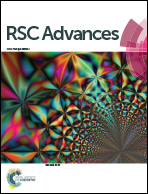A double core–shell modification of bulk TiO2 microspheres into porous N-doped-graphene carbon nanoflakes/N-doped TiO2 microspheres for lithium-ion battery anodes†
Abstract
In this study, we modified bulk TiO2 microspheres—using a template-aided, double core–shell modification with N-doped carbon (NC) and N-doped graphene (NG)—for the purpose of forming porous N-doped graphene carbon nanoflakes/N-doped TiO2 (NG–NC/NTiO2) microspheres. The effects of surface modification on the properties of the TiO2 microspheres and the resultant electrochemical performance in a lithium-ion-battery (LIB) anode were thoroughly investigated. The double core–shell modified nanocomposite exhibited a specific capacity of 74 mA h g−1 at a 10 C rate, which was much higher than the capacities of TiO2, carbon/TiO2, and core–shell NC/NTiO2 nanocomposites at rates of 0.2, 1, and 5 C, respectively. The RGO of the double core–shell NC/NTiO2 nanocomposite provided an effective buffering effect for the TiO2 microsphere, resulting in a much lower initial specific-capacity loss of 19.6%, on the 200th cycle, in comparison with the 41.8% loss of the core–shell NC/NTiO2 nanocomposite at the same cyclic stage. Such excellent performances from the TiO2 microspheres with the double core–shell assembly in the LIB anode were attributed to a significant reduction of charge transfer resistance (Rct) and maintenance of electrode stability.


 Please wait while we load your content...
Please wait while we load your content...